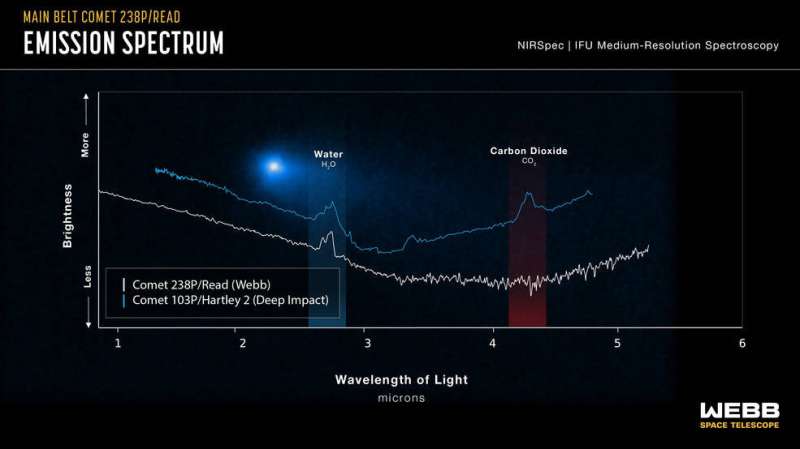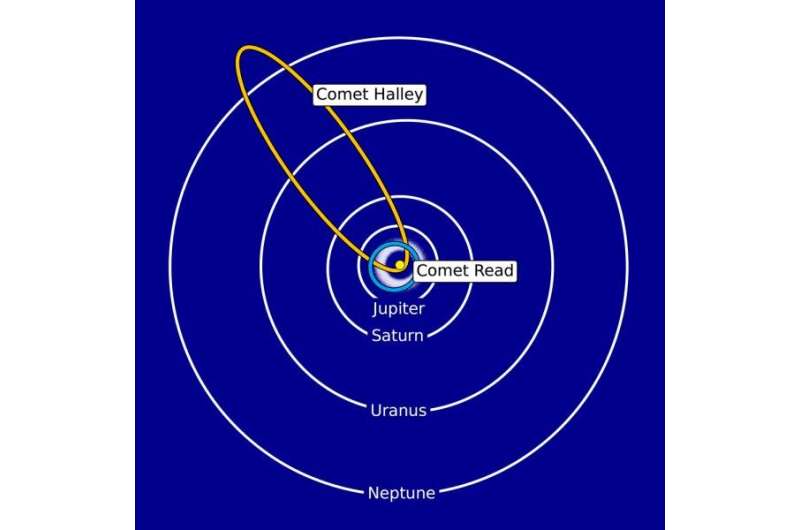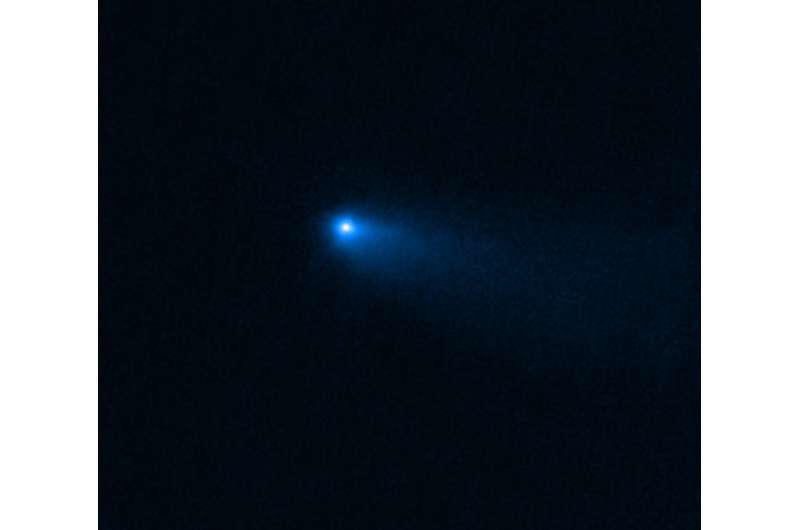This article has been reviewed according to Science X's editorial process and policies. Editors have highlighted the following attributes while ensuring the content's credibility:
fact-checked
peer-reviewed publication
trusted source
proofread
James Webb Space Telescope detects outgassing water from main-belt comet

After 15 years of attempts, researchers using the James Webb Space Telescope (JWST) have for the first time successfully detected water outgassing from a main-belt comet.
A recently published Nature paper "Direct detection of water from a main-belt comet with JWST" led by Michael Kelley of the University of Maryland reports the first direct spectroscopic detection of water outgassing from a main-belt comet named Comet Read. Planetary Science Institute Senior Scientist Henry Hsieh is a co-author on the paper.
Main-belt comets are a rare sub-class of comets that have mostly circular orbits entirely confined to the main asteroid belt between the orbits of Mars and Jupiter, but show comet-like behavior—ejecting material that creates a fuzzy appearance and often tails—that astronomers believe is produced by sublimation—or the transition of ice directly to gas—of icy material.
Only dust has ever been detected being ejected by main-belt comets though, despite many attempts to detect escaping gases that should also accompany sublimation-powered cometary activity. Most main-belt asteroids are not expected to have much ice, given their location in the warm inner solar system where they are thought to have resided for billions of years.

For comparison, most other comets that display activity caused by sublimation spend large portions of their time in the cold outer solar system on highly elongated orbits that only occasionally pass through the inner solar system. Given these considerations, doubts have persisted about whether main-belt comets could really be icy. Until now.
"Since the discovery of main-belt comets, we have collected a substantial body of evidence that their activity is produced by sublimation, but until now, it has all been indirect. This new result from JWST represents the first direct evidence of sublimation in the form of water outgassing—or outgassing of any kind—from a main-belt comet, following studies dating back to 2008 to detect outgassing in main-belt comets using some of the biggest ground-based telescopes in the world," explained Hsieh, who led the discovery of main-belt comets as a new kind of comet in 2006.
In the paper, Hsieh and his colleagues further find that Comet Read, and therefore possibly other main-belt comets as well, has a fundamentally different chemical composition from other comets, showing almost no carbon dioxide, a common component of cometary outgassing, relative to the amount of water found. Whether it experienced different formation circumstances or evolutionary history,
Comet Read is unlikely to be a recent asteroid belt interloper from the outer solar system. Based on these results, main-belt comets appear to represent a sample of volatile material that is currently unrepresented in observations of classical comets and the meteoritic record, making them important for understanding the early solar system's volatile inventory and its subsequent evolution.

"Because substantial water ice—which is a major component of the volatile material that typically produces activity in 'classical' comets from the outer solar system—is unexpected in main-belt asteroids given how close to the sun they are, there has always been some doubt about whether main-belt comet activity is produced by water ice sublimation rather than some other process that doesn't involve ice, such as impacts or material being flung into space by fast-spinning asteroids," Hsieh said.
"Water in main-belt comets is important because objects from the main asteroid belt have been proposed as a potential source of Earth's water in the early solar system, where the modern day main-belt comets appear to provide an opportunity to test this hypothesis. This only works though if they do in fact contain water ice. The confirmation of water outgassing in at least one main-belt comet confirms that learning about the origin of Earth's water from main-belt comets is a viable possibility," Hsieh said.
The team used JWST to observe Read shortly after its close approach to the sun, when outgassing was expected to be at its strongest, taking both imaging and spectroscopic observations at near-infrared wavelengths in order to search for characteristic spectroscopic features of water vapor and other common gases produced by cometary sublimation.
More information: Kelley, M.S.P. et al. Spectroscopic identification of water emission from a main-belt comet. Nature (2023). DOI: 10.1038/s41586-023-06152-y www.nature.com/articles/s41586-023-06152-y
Journal information: Nature
Provided by Planetary Science Institute





















